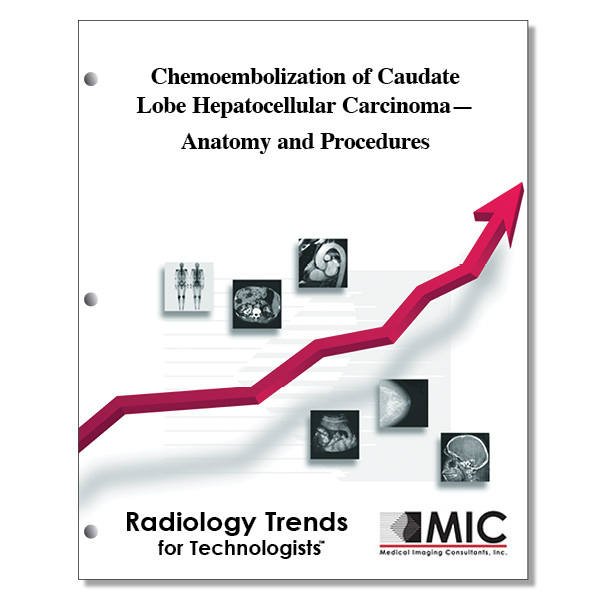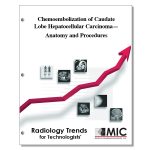

Chemoembolization of Caudate Lobe Hepatocellular Carcinoma—Anatomy and Procedures
A review of the anatomy of the caudate artery and a description of considerations in selective chemoembolization for caudate lobe hepatocellular carcinoma.
Course ID: Q00594 Category: Radiology Trends for Technologists Modalities: CT, Radiation Therapy, Vascular Interventional1.75 |
Satisfaction Guarantee |
$24.00
- Targeted CE
- Outline
- Objectives
Targeted CE per ARRT’s Discipline, Category, and Subcategory classification for enrollments starting after January 27, 2023:
[Note: Discipline-specific Targeted CE credits may be less than the total Category A credits approved for this course.]
Computed Tomography: 1.25
Procedures: 1.25
Abdomen and Pelvis: 1.25
Registered Radiologist Assistant: 1.75
Procedures: 1.75
Neurological, Vascular, and Lymphatic Sections: 1.75
Sonography: 1.25
Procedures: 1.25
Abdomen: 1.25
Vascular-Interventional Radiography: 1.75
Procedures: 1.75
Vascular Diagnostic Procedures: 1.25
Vascular Interventional Procedures: 0.50
Vascular Sonography: 1.25
Procedures: 1.25
Abdominal/Pelvic Vasculature: 1.25
Outline
- Introduction
- Anatomy of the Caudate Lobe
- C-Arm CT
- Caudate Artery
- HCCs in the Caudate Lobe
- HCC in the Spiegel Lobe
- HCC in the Paracaval Portion
- HCC in the Caudate Process
- Recurrent Tumors in the Caudate Lobe
- HCCs with Portal Vein or Bile Duct Invasion
- Chemoembolization through the Caudate Artery
- Bile Duct Stricture
- Conclusion
Objectives
Upon completion of this course, students will:
- be familiar with the difficulties of performing chemoembolization and percutaneous ablation on patients with HCCs located in the caudate lobe
- identify the modality that assists interventional radiologists when performing transarterial chemoembolization in tumors of the caudate lobe
- be familiar with the anatomy of the caudate artery
- be familiar with the anatomy of the caudate lobe of the liver
- be familiar with the anatomy and location of the caudate process
- identify the proper catheter for use in the common hepatic artery
- be familiar with the injection rate of undiluted contrast material when imaging the caudate lobe with C-arm CT
- be familiar with the ability for C-arm CT to identify tumor-feeding arteries of the caudate lobe
- identify the location of the Spiegel lobe in the caudate of the liver
- be familiar with the hepatic arteries
- be familiar with the vascular network of the hepatic ducts
- identify the location of the two marginal arteries located along the common bile duct
- be familiar with the common origins of the caudate artery
- identify the Spiegel lobe during the axial portal venous phase CT
- be familiar with the paracaval portion of the caudate lobe
- identify the middle hepatic artery as an origin for the caudate artery
- identify the accumulation of iodized oil in an axial CT image
- be familiar with the arteries supplying an HCC in the paracaval portion of the caudate lobe
- be familiar with the role the right hepatic artery plays in supplying blood to HCCs located in the caudate process.
- be familiar with the most common extrahepatic collateral artery supplying recurrent tumors in the caudate lobe
- identify the less common vessels that supply recurrent tumors in the caudate lobe
- be familiar with the effective and safe treatment of HCCs with chemoembolization
- be familiar with the sloughing of the biliary tumor thrombus after selective chemoembolization
- be familiar with the materials employed when treating HCCs with chemoembolization
- be familiar with the inadvertent embolization that can occur when embolic materials are forcefully injected into one caudate artery
- be familiar with techniques used to perform selective catheterization on the caudate artery
- be familiar with successful microcatheter techniques used in chemoembolization
- be familiar with the reported incidence of bile duct stricture due to chemoembolization through the caudate artery
- identify the location of the paracaval portion of the liver
- identify the factors that enable safe and effective treatment of caudate lobe HCCs
